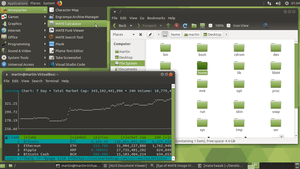MATE (software)
 | |
 Ubuntu Mate | |
| Developer(s) | Stefano Karapetsas, et. al.[1] |
|---|---|
| Initial release | August 19, 2011 |
| Stable release | |
| Repository |
|
| Written in | C, C++, Python[4] |
| Operating system | Unix-like with X11 (X Window System) |
| Type | Desktop environment |
| License | GNU LGPLv2, GNU GPLv2 |
| Website |
mate-desktop |
MATE (/ˈmɑːteɪ/) is a desktop environment composed of free and open-source software that runs on Linux and most BSD derivatives.
An Argentine user of Arch Linux started the MATE project to fork GNOME in response to the negative reception of GNOME 3, which controversially replaced its traditional desktop interface with GNOME Shell (an abstract, task-based interface), and calls for continued development of the officially-deprecated GNOME 2. MATE aims to maintain the existing GNOME 2 code base, frameworks, and core applications.[5][6][7]
Name
It is named after the South American plant yerba mate and tea made from the herb, mate.[8] The name was originally all capital letters to follow the nomenclature of other Free Software desktop environments like KDE and LXDE. The recursive backronym "MATE Advanced Traditional Environment" was subsequently adopted by most of the MATE community, again in the spirit of Free Software like GNU ("GNU's Not Unix!"). The use of a new name, instead of GNOME, avoids naming conflicts with GNOME 3 components.
Software components
MATE has forked a number of applications which originated as GNOME Core Applications, and developers have written several other applications from scratch. The forked applications have new names, most of them from Spanish.
MATE applications include:
- caja (box) – file manager (from Nautilus)
- pluma (quill/feather/pen) – text editor (from Gedit)
- atril (lectern) – document viewer (from Evince)
 Ubuntu MATE 18.04 with the MATE Desktop Environment version 1.20
Ubuntu MATE 18.04 with the MATE Desktop Environment version 1.20 - engrampa (staple) – archive manager (from Archive Manager)
- mate-terminal – terminal emulator (from GNOME Terminal)
- marco (frame) – window manager (from Metacity)
- mozo (waiter) – menu-item editor (from Alacarte)
Further development

MATE fully supports the GTK+ 3 application framework. The project is supported by Ubuntu MATE lead developer Martin Wimpress and by the Linux Mint development team:
"We consider MATE yet another desktop, just like KDE, Gnome 3, Xfce etc… and based on the popularity of Gnome 2 in previous releases of Linux Mint, we are dedicated to support it and to help it improve. The most popular Linux desktop was, and arguably is, Gnome 2."[9]
New features have been added to Caja such as undo/redo[10] and diff viewing for file replacements.[11]
MATE 1.6 removes some deprecated libraries, moving from mate-conf (a fork of GConf) to GSettings, and from mate-corba (a fork of GNOME's Bonobo) to D-Bus.[12]
Releases history
| Date | Version |
|---|---|
| 2011-06-18 | Announced at Arch Linux forum |
| 2011-08-19 | Initial release |
| 2012-04-16 | 1.2 |
| 2012-07-30 | 1.4 |
| 2013-04-02 | 1.6 |
| 2014-03-04 | 1.8 |
| 2014-09-29 | 1.8.1 |
| 2015-03-13 | 1.8.2 |
| 2015-06-11 | 1.10 |
| 2015-11-05 | 1.12 |
| 2016-04-08 | 1.14 |
| 2016-09-21 | 1.16 |
| 2017-03-13 | 1.18 |
| 2018-02-07 | 1.20 |
Adoption
MATE 1.2 was released on 16 April 2012. MATE has been one of the default desktop environments shipped with Linux Mint since version 12 "Lisa",[13][14] LMDE since "201303",[15][16][17][18] Sabayon Linux since release 10,[19] a Fedora spin (since Fedora 18),[20] and as the desktop environment in Ubuntu MATE 14.10.[21]
MATE is also available in the official repositories of several other Linux distributions, including Arch Linux, Parabola, LMDE, Debian, Ubuntu MATE, Linux Mint, Kali Linux, Fedora, openSUSE, Gentoo, Mageia, ROSA, and PCLinuxOS.[22] Aside from that, there are third party repositories for Slackware.[23] Version 3.5 and up of GhostBSD include MATE as the default desktop environment, making it the second inclusion of MATE as a default desktop, after Linux Mint,[24] and the first in a non-Linux OS. It is also available for FreeBSD (alongside its derivatives, such as PC-BSD)[25] and NetBSD[26] and is default on OpenIndiana.[27]
Arch Linux
MATE was initially announced on the Arch Linux forum on 18 June 2011,[28] and became official community package in January 2014.
Parabola
Parabola is a popular Arch derivative and the first Linux distribution to use MATE as its default desktop environment.[29]
Trisquel
Since Flidas alpha (its version 8), Trisquel has begun to adopt MATE 1.18 instead of GNOME desktop environment.
Ubuntu MATE
In November 2014, the Ubuntu MATE team released version 14.04 LTS, which will be supported until April 2019.[30]
In March 2015, Ubuntu MATE was granted official Ubuntu flavour status from version 15.04 onwards.[31]
Slackware
MATE is available for Slackware users via MSB (Mate SlackBuilds) project. SlackBuild script for MATE can be obtained from GitHub.
See also
References
- ↑ MATE Developers
- ↑ Wimpress, Martin (2018-02-07), MATE 1.20 released, retrieved 2018-02-07
- ↑ "mate-desktop - Library with common API for various MATE modules". git.mate-desktop.org.
- ↑ "MATE". github.com. Retrieved 12 April 2015.
- ↑ "A Gnome 2 Fork: The MATE Desktop Environment", ingeek, 2011-11-17, archived from the original on 2014-02-14, retrieved 2016-12-12
- ↑ Larabel, Michael (2011-08-17), "A Fork Of GNOME 2: The Mate Desktop", Phoronix, retrieved 2011-12-04
- ↑ Laishram, Ricky (2011-08-04), Linus Torvalds Ditches GNOME For Xfce, Digitizor, retrieved 2011-11-08,
While you are at it, could you also fork gnome, and support a gnome-2 environment? – Linus Torvalds
. - ↑ "MATE Desktop Environment - Where does the name come from?", MATE, retrieved 2015-07-03
- ↑ Lefebvre, Clem (2011-12-01), "Important fix for MATE – Feedback needed", The Linux Mint Blog, retrieved 2011-12-10
- ↑ Karapetsas, Stefano (2012-01-03), "Undo/Redo in Caja", Stefano Karapetsas's Blog, retrieved 2014-04-15
- ↑ Karapetsas, Stefano (2012-06-17), "What's new in next Caja", Stefano Karapetsas's Blog, retrieved 2014-04-15
- ↑ "MATE: Roadmap". Retrieved 7 January 2013.
- ↑ Lefebvre, Clem (2011-11-26), "Linux Mint 12 Release Notes", Linux Mint, retrieved 2011-12-04
- ↑ Holwerda, Thom (2011-11-27), "Linux Mint 12 Released", OSNews, retrieved 2011-12-05
- ↑ "Linux Mint Debian 201303 released!". The Linux Mint Blog. 2010-07-21. Retrieved 2013-03-25.
- ↑ "Linux Mint 13 MATE". Desktop Linux Reviews. May 24, 2012. Retrieved 2013-10-09.
- ↑ "Linux Mint 14 MATE". Desktop Linux Reviews. January 2, 2013. Retrieved 2013-10-09.
- ↑ "Linux Mint 15 Olivia MATE review". Linux and Life. June 2, 2013. Retrieved 2013-10-09.
- ↑ lxnay (2012-09-13), "Press Release. Sabayon 10", Sabayon Linux, retrieved 2012-09-15
- ↑ Mashal, Dan; Dieter, Rex (2012-07-19), "Features/MATE-Desktop", Fedora Wiki, retrieved 2012-09-15
- ↑ "Ubuntu MATE Utopic final release/". Retrieved 1 November 2014.
- ↑ "Which distributions support MATE?". Retrieved 23 August 2014.
MATE is available via the official repositories for the following Linux distributions: Arch Linux Debian Fedora Gentoo Linux Mint Mageia openSUSE PCLinuxOS PLD Linux Point Linux Sabayon Salix Ubuntu
- ↑ "MATE Desktop Environment - Which distributions support MATE?", MATE, retrieved 2014-04-28
- ↑ "3.5 "Levi" Released". GhostBSD. Retrieved 2014-04-02.
- ↑ "The FreeBSD GNOME Project".
- ↑ "DistroWatch.com: NetBSD".
- ↑ "Illumos based OpenIndiana MATE 2016.08.16 released". OpenSourceFeed. Retrieved 2016-10-07.
- ↑ "Mate Desktop Environment - GNOME2 fork". bbs.archlinux.org. Perberos. Retrieved 22 August 2014.
- ↑ "Get Parabola". ParabolaWiki.
- ↑ Sneddon, Joey-Elijah. "Ubuntu MATE 14.04 LTS Now Available to Download". omgubuntu.co.uk. Retrieved 15 November 2014.
- ↑ Sneddon, Joey (1 March 2015). "Ubuntu 15.04 Beta Available to Download, Ubuntu MATE Is Now An Official Flavor". OMG Ubuntu. Retrieved 1 March 2015.
External links
| Wikimedia Commons has media related to MATE (desktop environment). |

